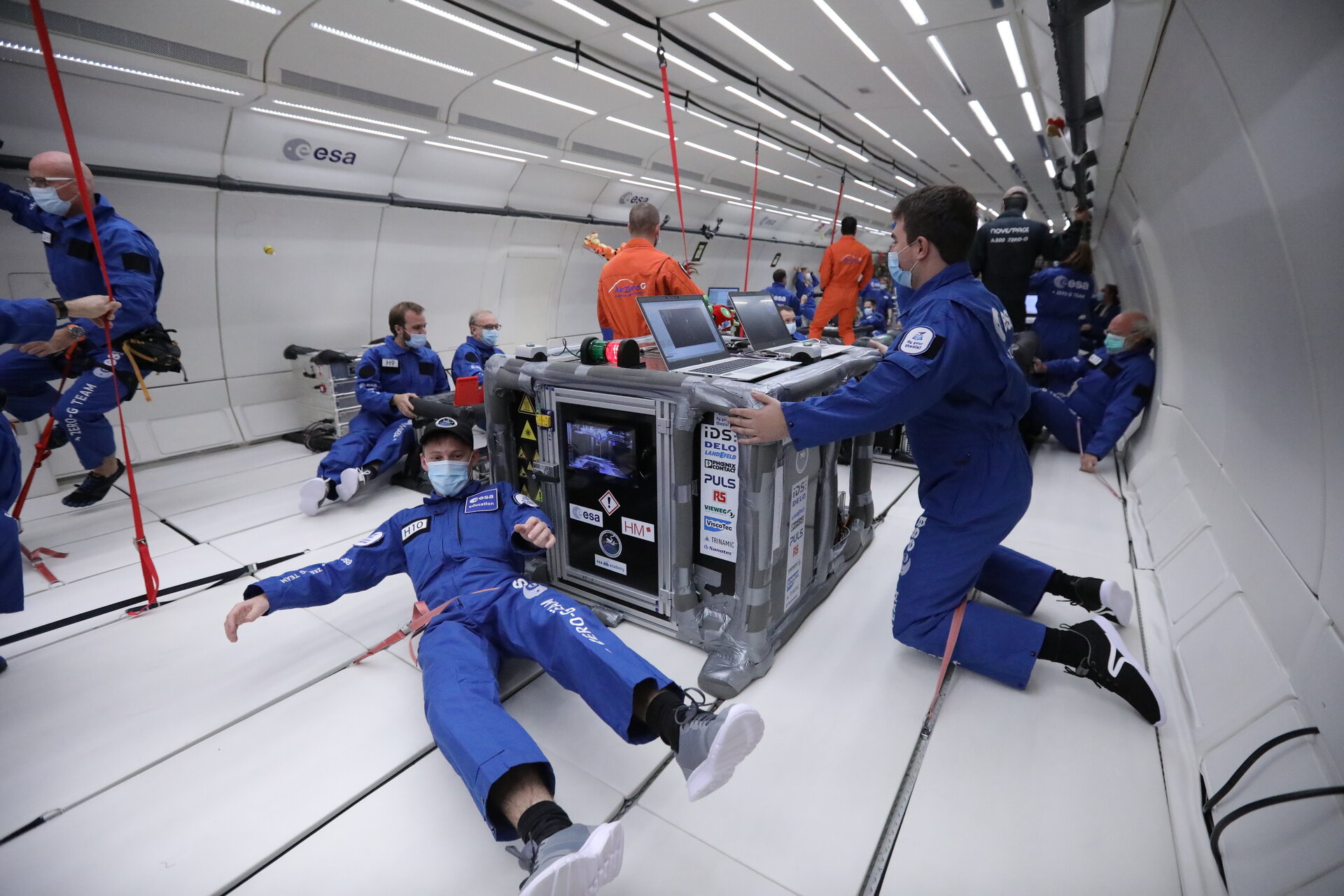Fly Your Thesis! campaign concludes under extraordinary Covid-19 measures
Last week, in what can only be described as extra-ordinary circumstances, 8 university students took to the skies for the Fly Your Thesis! 2020 campaign.
AIMIS-FYT team from Applied Sciences University in Munich in Germany and team RELOX from Universities of Manchester and Glasgow in the UK, overcame many unforeseen obstacles and hardships to participate in this unique parabolic flight campaign, where the safety and well-being of all participating was of paramount importance. With the right measures in place to ensure the utmost Covid-19-safe environment, the campaign concluded successfully and the students obtained all the data they were expecting!

Few could have predicted in late 2019 when student teams were selected for the following year’s Hands-on Programmes, that Covid-19 would have been so disruptive to so many around the globe. The same was true for the Fly Your Thesis! students who just two months into the development of their experimental hardware, were told that access to their university was to be revoked as of immediate effect to curb the spread of the virus.
In normal circumstances, Fly Your Thesis! students have less than a year to design, build and test their hardware, an already incredibly tight schedule, which because of the various lockdowns was now squeezed to such an extent that the teams were unsure whether the deadlines could be met.
Meanwhile, throughout the year, ESA and Novespace were meticulously preparing appropriate countermeasures that would enable a campaign to go ahead with maximum care for the safety of the scientists, students and crew. This meant that the campaign was moved from its nominal site on Novespace premises in Merignac, Bordeaux, France to another airport in the east of North Rhine Westfalen region in Germany, near Paderborn. Other than the location change, many other smaller but significant measures were planned such as ensuring negative Covid-19 PCR prior to coming to Germany, regular temperature taking, strict social distancing in the large preparation hangar, obligatory mask wearing at all times, limited number of experimenters on the aircraft at any time, and adaptations to the aircraft seating arrangement. Thus, following careful evaluations in consultation with local authorities and medical staff, ESA and Novespace were able to give green light for the campaign.
ESA Academy and Novespace therefore continued to follow the progress of the teams extremely closely and were pleasantly surprised at the ingenuity and resourcefulness that the students conjured up in order to complete the necessary steps to make it to the campaign with functional hardware.
Following the national guidelines from their home countries as well as Germany, both teams travelled to Paderborn in time to finalise the assembly on site and to support the loading of their hardware onto the aircraft for the 93 zero g parabolas that the experiments, and students, would be subjected to for the following 3 days. Parabolic flights create a unique environment of relative weightlessness as the aircraft projects everything and everyone in it into a ballistic trajectory for a period of 22 seconds per parabola. The aircraft, essentially protecting the contents of the fuselage from airdrag, performs this exceptional routine 31 times per day thus providing the scientists just over 30 minutes of weightlessness per campaign.

The AIMIS-FYT experiment worked very well throughout the 3 parabolic flight days with only minor video issues which turned out to be cosmetic rather than anything else. The team were investigating the technology necessary for printing extruded UV-curable resin into structures in the micro-gravity environment. Relatively complex truss segments and long ‘horizontal’ segments were printed with great accuracy and the team will spend the next few months analyzing not only the samples they printed, but also the thermal and visual camera recordings of the print heads.
Team RELOX collected all the data they wished for but encountered problems on their first flight day. Wanting to investigate the efficiency of hydrolysis at different g levels, the team created a 4-armed centrifuge each with an electrolysis cell encapsulated by cameras and lighting at the end. By rotating the centrifuge at different speeds, the team were able to recreate a series of g levels between 1g and 0g thus being able to determine the resistance across the cells and to visualize the fate of the gas bubbles at each electrode in reduced gravity. Various issues were encountered with some connections to the cells but these issues were solved for the next flights and the team were happy with their experimental results.
Despite the setbacks and the tremendous pressure on the teams to have everything finalized in a very short period of time, they walked away with a positive experience, “I got countless benefits out of this project. First of all, I could learn a lot in communication. I have never worked in an international setting like this before. So I could learn how to feel safe even if there are language barriers. I also could learn a lot in project planning. Every single task took longer than I was expecting. In the future I may estimate the amount of work better. And of course there were many engineering challenges to solve which helped me to get professional experience,” said one student from AIMIS-FYT team.
Whilst the flight days may be over, the project is not yet finished, the team will analyse their data and report back to ESA Academy within 4 months. Because at first sight the results look interesting for both teams, several publications and conference presentations are expected too!
Currently, ESA Academy and partners are reviewing the Fly Your Thesis! 2021 applications and will, in the next few weeks, select the teams to start the design and development of the new batch of experiments, and to fly in one year’s time.


